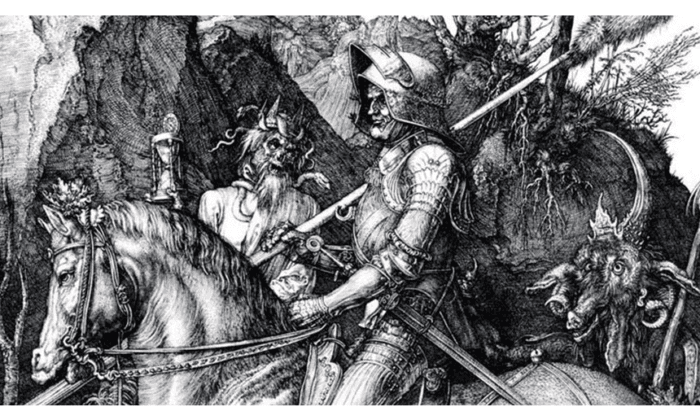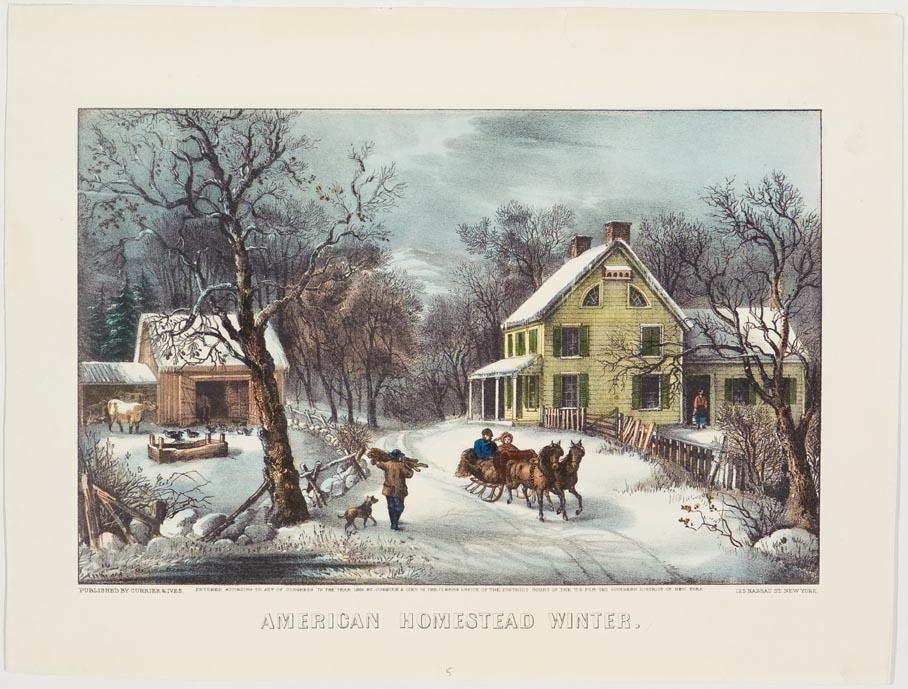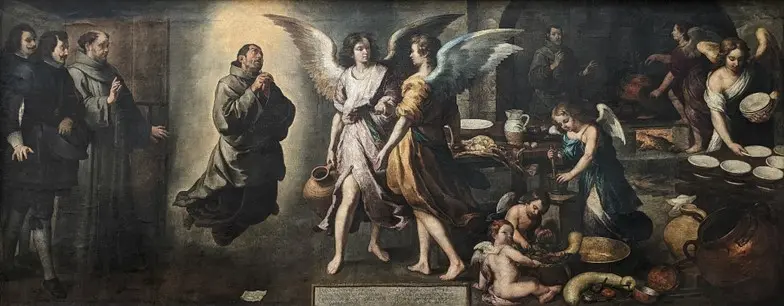The knight was going home. As he rode along a dim, dangerous, and narrow mountain path, dark beings plagued his every step. He had faced great terrors in his life, and these demons fazed him not.
He calmly rides forward on his mighty warhorse, his loyal hound at his side. The path meanders upward; the knight has a long way to go on this perilous journey.
At the height of his artistic career, Albrecht Dürer (1471–1528) made three copper engravings, now known as his master prints or “Meisterstichte.” Together, they reflect on the most important aspects of a person—the mind, body, and spirit.
Symbols of Life’s Journey
In the right foreground just above the artist’s iconic signature of a D wrapped in an A, sits a memento mori skull on a rock, which represents the shortness of life. At the lower right, a lizard, which represents spiritual ardor in the face of danger, moves in and around the knight’s warhorse. A hound, symbolizing loyalty, runs at pace and stays close.
Moving up from the sabatons (foot armor), our eyes fall on the magnificent steed. The artist visited Italy twice and used Leonardo da Vinci’s proportions for this depiction of a horse. Similarities to equestrian statues by Donatello and Andrea del Verrocchio that he viewed while in Italy also can be found here.
The knight’s journey home holds many dangers not seen by the physical eye, but they are very real nonetheless. Dürer shows two dark forces close by. Death rides alongside the knight on a pale horse. Snakes wrap themselves around Death’s neck and headpiece, a truly horrific figure. As he stares and smiles at the knight, Death holds a half-empty hourglass to signify that the knight’s life is half over.
The devil, the demonic creature trailing the knight, has a monstrous appearance. The many temptations in life—gluttony, lust, power, and others—are symbolized by the pig’s snout, ram’s horns, and the large horn of fire erupting from the top of its head.
The landscape is bare and rocky. Boulders expose dying roots and show cracks along the barren cliffside. High in the background, a settlement holds buildings and a luxuriant landscape in contrast to the dangerous and bleak path on the way up.
The knight keeps his face forward, with an eye on his destination—his heavenly home. He treks through a world that is rotting away, dark and unsustainable. In his hand, he holds a flower of hope that keeps him mindful of where he is going.

Protecting Oneself
In referring to this engraving, Renaissance artist and art historian Giorgio Vasari noted that the knight symbolizes human strength, and he is indeed strong in the face of many dangers along his life’s journey. The knight protects his mortal body with the best armor of the day, and Dürer depicts it grandly.A Master Engraver

Engravers used tools that were difficult to master but could produce compositions of depth and precision. This engraving shows Dürer’s skill in using engraving tools with a range of techniques. The dark, rotted landscape, for instance, is a wide flat surface that Dürer composed to create depth for the main figures. Different kinds of crosshatching build interest in the horse’s mane, the creatures’ beards, and the dog’s shaggy coat. Shading shows the musculature of the horse to great effect.
Death is always with us as we go through life; we do not know when it will interrupt and end our life’s journey. The Devil has made himself known more boldly in recent times, especially to those who agree to or are enticed by his blandishments.
The knight’s journey is one that we all must take. We have a mortal body, and we—like the knight—must protect ourselves from all sorts of demonic interference and life-threatening assaults on our way to our heavenly home.

With masterful skill, Dürer presented scenes filled with symbols and figures that ask the viewer to think about, meditate, and act upon in one’s life.
When Dürer first produced the print, he named it “Reuter” (“Rider”). In this and his other master engravings, Dürer made use of his immense talent, growing artistic insight, and increased technical skill to create classical perfection in this piece, the second of his master engravings.








